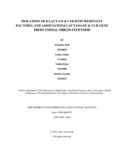Isolation of β-Lactam & Colistin Resistant Bacteria and associated β-Lactamase & CLR Gene from animal originated food
Abstract
After the COVID-19 outbreak, the emergence of antimicrobial resistance among bacterial pathogens is
another concern for public health. This study was designed to investigate the presence of multi-drug
resistant β-lactamase producing and colistin resistant bacteria in raw meat, fish and milk sample collected
from the local market.
Carcass of fish (12), chicken (11) and beef samples (10) along with pasteurized milk (10) samples were
aseptically collected from the local market of Mohakhali and Karwan Bazar. The samples were processed
accordingly and cultured on selective & non-selective media. Single colonies were selected from
selective media depending on their colony morphology and cultural characteristics and a series of
biochemical tests were conducted for the confirmation of the selected isolates. Subsequently, antibiotic
profiling was done through Kirby-Bauer disk-diffusion method for identifying multi-drug resistant bacteria.
Finally, Carbapenem & colistin resistant isolates were screened by PCR for detection of the antibioticresistant genes. Afterward, the hemolysis pattern of the carbapenem & colistin resistant isolates was
observed in blood agar plates.
A total of 400 isolates of gram-positive & gram-negative bacteria were randomly selected from 43 samples
by observing distinct colony morphology. Escherichia coli (23.87%) and Klebsiella spp. (21.86%) was the
predominant species followed by Pseudomonas spp. (9.05%), Yersinia spp. (8.8%), Shigella spp. (7.03%),
Providencia spp. (5.28%), Citrobacter spp. (5.02%), Salmonella spp. (4.77%), Proteus spp. (3.27%),
Pasteurella multocida (3.27%), Streptococcus spp. (2.76%), Enterococcus spp. (2.01%), Enterobacter spp.
(1.76%) and Moraxella catarrhalis (1.26%). Around 72.56% of isolates were resistant to ampicillin, 50.9%
were resistant against 4th generation cephalosporin (cefepime), 12.02% were found to be resistant to
carbapenem, 12.63% showed resistance against colistin and 22% isolates resisted at least 4 groups of
antibiotics. The presence of bla-NDM gene was detected from 11 isolates and NDM gene was found from
7 isolates followed by bla-TEM gene in 6 isolates, bla-IMP gene in 2 isolates & bla-CTX-M gene in 5
isolates from 48 carbapenem-resistant isolates along with the presence of CLR gene was detected in 19
isolates from 58 colistin resistant isolates which were confirmed by Polymerase chain reaction (PCR)
analysis. While observing the hemolysis pattern of 48 carbapenem resistant isolates, 22.91% isolates were
alpha hemolytic, 16.66% were β hemolytic. Subsequently out of 58 colistin resistant isolates, 54% showed
alpha hemolysis and 46% isolates showed β hemolysis.
The study reveals the alarming emergence of β-lactam & colistin resistant bacteria which is a serious public
health concern. Due to horizontal gene transfer, these resistant genes can be shared by pathogens which
might be a cause of another pandemic.

